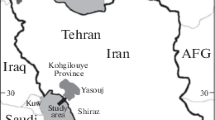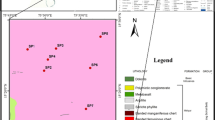Abstract
The weathering profile, exposed at 38.2 km of the Kuala Lumpur—Karak Highway, can be differentiated into three broad zones; the topmost Zone I (pedological soil) comprising A, B and C soil horizons and made up of clayey silty sand with indistinct relict bedrock textures. The intermediate Zone II (saprock) consists of gravelly silty sand with distinct relict bedrock texture and structures, and can be sub-divided based on differences in volumes of litho-relicts. The bottom Zone III (bedrock) is a continuous outcrop of rhyolite with alteration along discontinuity planes; its upper surface marked by an unconfined groundwater table. The weathering zones thin towards valley sides and can be assigned rock mass weathering grades; Zones I and II defining the residual soil over bedrock. Constant volume samples in Zone II show an upward decrease in dry unit weights, porosities and silt contents, but a corresponding increase in clay contents. Constant volume samples in Zone I show it to be distinct from Zone II with large clay contents but low porosities and silt contents. Decreasing fine clay contents with depth and stained quartz grains show pedological processes to have given rise to Zone I. As the silt-sized (sericite) particles mainly originate from alteration of bedrock feldspars and later break-down to clay-sized (illite and kaolinite) particles, a textural weathering index (Iw) based on the ratio of clay to silt and clay contents, is proposed to describe the progress of weathering within the profile. It is concluded that the saprock results from in situ alteration of the rhyolite rock mass due to lowering of an unconfined groundwater table whilst the A, B and C soil horizons have formed by pedological processes acting on saprock.
Similar content being viewed by others
References
Anon (1995) The description and classification of weathered rocks for engineering purposes (Working Party Report). Q J Eng Geol 28:207–242
Arikan F, Ulusay R, Audin N (2007) Characterization of weathered acidic volcanic rocks and a weathering classification based on a rating system. Bull Eng Geol Environ 66:415–430
Aydin A (2006) Stability of saprolitic slopes: nature and role of field scale heterogeneities. Natl Hazards Earth Syst Sci 6:89–96
Azman AG, Singh N (2005) Petrology and geochemistry of the Sempah Volcanic Complex. Bull Geol Soc Malays 51:103–121
Bell FG (2000) Engineering properties of soils and rocks. Blackwell Science Ltd., Oxford
Bockheim JG, Gennadiyev AN, Hammer RD, Tandarich JP (2005) Historical development of key concepts in pedology. Geoderma 124:23–36
BSI, British Standards Institution, (1981) Code of practice for site investigations, BS 5930:1981. British Standards Institution, London
Carroll D (1970) Rock weathering. Plenum Press, New York
Chakraborty KR (1995) Genting Sempah volcanic complex: genetic implications for the main range granite. Newslett Geol Soc Malays 21:216–217
Cobbing EJ, Mallick DIJ (1987) Southeast Asia granite project—field report for peninsular Malaysia. Overseas Directorate, British Geological Survey, Nottingham
Dearman WR (1974) Weathering classification in the characterisation of rock for engineering purposes in British practice. Bull Int Assoc Eng Geol 9:33–42
Dearman WR (1976) Weathering classification in the characterisation of rock: a review. Bull Int Assoc Eng Geol 13:123–127
Deer WA, Howie RA, Zussman J (1977) an introduction to the rock forming minerals. Longman Group Ltd., London
Deere DV, Patton FD (1971) Slope stability in residual soils. In: Proceedings VI Pan-American conference on soil mechanics and foundation engineering, Puerto Rico vol 1, pp 87–170
Duzgoren-Aydin NS, Aydin A (2006) Chemical and mineralogical heterogenities of weathered igneous profiles: implications for landslide investigations. Natl Hazards Earth Syst Sci 6:315–322
Duzgoren-Aydin NS, Aydin A, Malpas J (2002) Re-assessment of chemical weathering indices: case study on pyroclastic rocks of Hong Kong. Eng Geol 63:99–110
Eggleton RA (2001) The regolith glossary—surficial geology, soils and landscapes. National Capital Publishing, Canberra
Ehlen J (2005) Above the weathering front: contrasting approaches to study and classification of weathered mantle. Geomorphology 67:7–21
Fookes PG, Dearman WR, Franklin JA (1972) Some engineering aspects of weathering with field examples from Dartmoor and elsewhere. Q J Eng Geol 3:1–24
GBRRL, Great Britain Road Research Laboratory (1959) Soil mechanics for road engineers. Her Majesty’s Stationery Office, Great Britain
GCO, Geotechnical Control Office, (1988) Guide to rock and soil descriptions, geoguide 3. Geotechnical Control Office, Hong Kong
GSL, Geological Society of London (1990) Tropical residual soils. Geological Society Working Group Report. Q J Eng Geol 23:1–102
Haile NS, Stauffer PH, Krishnan D, Lim TP, Ong GB (1977) Palaeozoic redbeds and radiolarian cherts: reinterpretation of their relationships in the Bentong and Raub areas, West Pahang, Peninsular Malaysia. Bull Geol Soc Malays 8:45–60
Hamdan J, Burnham CP (1996) The contribution of nutrients from parent materials in three deeply weathered soils of Peninsular Malaysia. Geoderma 74:219–233
Hamdan J, Burnham CP (1997) Physico-chemical characteristics of three saprolites in Peninsular Malaysia. Commun Soil Sci Plant Anal 28(19–20):1817–1834
IAEG, International Association Engineering Geology (1981) Rock and soil description for engineering geological mapping. Bull Int Assoc Eng Geol 24:235–274
Iliev IG (1966) An attempt to estimate the degree of weathering of intrusive rocks from their physico-mechanical properties. In: Proceedings 1st international congress rock mechanics, Lisbon, vol 1, 109–114
Irfan TY (1996) Mineralogy and fabric characterization and classification of weathered granitic rocks in Hong Kong. Geo Report No. 41, Geotechnical Engineering Office, Civil Engineering Department, Hong Kong
Irfan TY (1999) Characterization of weathered volcanic rocks in Hong Kong. Q J Eng Geol 32:317–348
Irfan TY, Dearman WR (1978a) Engineering classification and index properties of a weathered granite. Bull Int Assoc Eng Geol 17:79–90
Irfan TY, Dearman WR (1978b) The engineering petrography of a weathered granite in Cornwall, England. Q J Eng Geol 11:233–244
JKR, Public Works Department of Malaysia (2007) Guidelines for hard material/rock excavation. Technical Note (Roads) 24/05. Road Division, Jabatan Kerja Raya Malaysia
Karpuz C, Pasamehmetoglu AG (1997) Field characterization of weathered Ankara andesites. Eng Geol 46:1–17
Kiersch GA, Treacher RC (1955) Investigations, areal and engineering geology—Folsam Dam project, Central California. Econ Geol 50:271–310
Knill JL, Jones KS (1965) The recording and interpretation of geological conditions in the foundations of the Rosieres, Kariba and Latiyan Dams. Geotechnique 15:94–124
Lan HX, Hu RL, Yue ZQ, Fee CF, Wang SJ (2003) Engineering and geological characteristics of granite weathering profiles in South China. J Asian Earth Sci 21:353–364
Lee SG, De Freitas MH (1989) A revision of the description and classification of weathered granite and its application to granites in Korea. Q J Eng Geol 22:31–48
Liew TC (1977) Petrology and structural relationships of rhyolitic rocks and microgranodiorite, east of Genting Sempah, Pahang. B.Sc. (Hons) Thesis, Univ. Malaya, Kuala Lumpur
Liew TC, Page RW (1985) U-Pb zircon dating of granitoid plutons from the West Coast Province of Peninsular Malaysia. J Geol Soc 142:525–626
Little AL (1969) The engineering classification of residual tropical soils. In: Proceedings 7th international conference on soil mechanics and foundation engineering, Mexico, vol 1, pp 1–10
Lovegrove GW, Fookes PG (1972) The planning and implementation of a site investigation for a highway in tropical conditions in Fiji. Q J Eng Geol 5:43–68
Martin CP, Hencher SR (1986) Principles for description and classification of weathered rock for engineering purposes. In: Hawkins AB (ed) Site investigation practice, assessing BS 5930, Engineering Geology Special Publication 2, Geological Society of London, pp 299–308
Melton MA (1965) Debris covered hillslopes of the Southern Arizona desert—consideration of their stability and sediment contribution. J Geol 73:715–719
Moye DG (1955) Engineering geology for the Snowy Mountains scheme. J Inst Eng Aust 27:287–298
Ollier CS (1965) Some features of granite weathering in Australia. Zeischt Geomorfologie 9:285–304
Onodera TF, Yoshinaka R, Oda M (1974) Weathering and its relation to mechanical properties of granite. In: Proceedings 3rd congress, international society of rock mechanics, Denver, vol 2, pp 71–78
Parker A (1970) An index of weathering for silicate rocks. Geol Mag 103:501–504
Poppe LJ, Paskevich VF, Hathaway JC, Blackwood BS (2001) A laboratory manual for X-ray powder diffraction. United States Geological Survey Open-File Report 01-041
Rahardjo H, Aung KK, Leong EC, Rezaur RB (2004) Characteristics of residual soils in Singapore as formed by weathering. Eng Geol 73:157–169
Raj JK (1985) Characterisation of the weathering profile developed over a porphyritic biotite granite bedrock in Peninsular Malaysia. Bull Int Assoc Eng Geol 32:121–128
Raj JK (1998) The failure of a slope cut into the weathering profile developed over a porphyritic biotite granite. J Asian Earth Sci 16:419–427
Raj JK (2009) Geomorphology. In: Hutchison CS, Tan DNK (eds) Geology of Peninsular Malaysia. University of Malaya and Geological Society of Malaysia, Kuala Lumpur
Ruxton BP (1968) Measures of the degree of chemical weathering. J Geol 76:518–557
Ruxton BP, Berry L (1957) The weathering of granite and associated erosional features in Hong Kong. Bull Geol Soc Am 68:1263–1292
Singh N, Azman AG (2000) Sempah volcanic complex, Pahang. In: Teh GH, Pereira JJ, Ng TF (eds) Proceedings annual conference 2000, Geological Society of Malaysia, pp 67–72
Tandarich JP, Darmody RG, Follmer LR, Johnson DL (2002) Historical development of soil and weathering profile concepts from Europe to the United States of America. J Soil Sci Soc Am 66:335–346
Thomas MF (1974) Tropical geomorphology—a study of weathering and landform development in warm climates. MacMillan Press Ltd, Basingstoke
Thorez J (1975) Phyllosilicates and clay minerals—a laboratory handbook for their X-ray diffraction analysis. G. Lelotte, Belgium
Uriel S, Dapena E (1978) Influence of weathering on the mechanical properties of granitic rocks. In: Proceedings III international congress, international association of engineering geology, Madrid, vol 1, pp 91–104
USBR, United States Bureau of Reclamation (1974) Earth manual. United States Government Printing Office, Washington
Wentworth CK (1922) A scale for grade and class terms for clastic sediments. J Geol 30:377–392
Wesley L (2009) Behaviour and geotechnical properties of residual soils and allophane clays. Obras y Proyectos 6:5–10
Wesley L (2011) Stability of slopes in residual soils. Obras y Proyectos 10:47–61
Acknowledgement
Financial support for the preparation of this paper from the University of Malaya Research Grant 043/09AFR is gratefully acknowledged.
Author information
Authors and Affiliations
Corresponding author
Rights and permissions
About this article
Cite this article
Raj, J.K. Physical Characterization of a Deep Weathering Profile Over Rhyolite in Humid Tropical Peninsular Malaysia. Geotech Geol Eng 36, 3793–3809 (2018). https://doi.org/10.1007/s10706-018-0572-1
Received:
Accepted:
Published:
Issue Date:
DOI: https://doi.org/10.1007/s10706-018-0572-1








